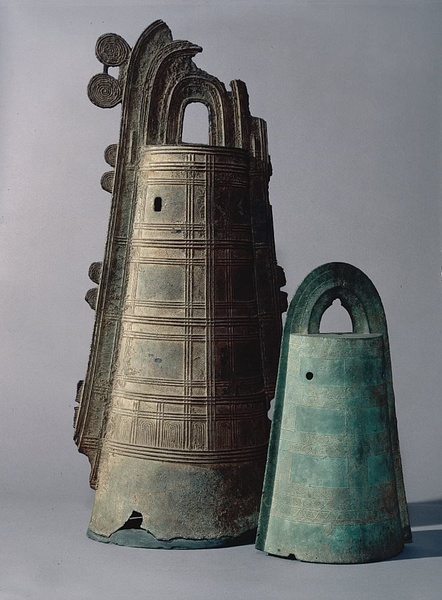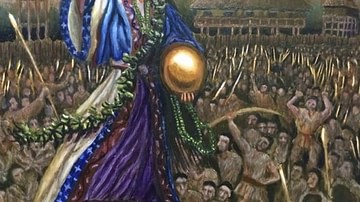
The Yayoi Period is one of the oldest historical periods of Japan spanning from c. 300 BCE to c. 250 CE, preceded by the Jomon Period and followed by the Kofun Period. The name Yayoi comes from the district in Tokyo where the first artifacts associated with the period were found in 1884 CE. During this time period rice farming and metalworking advance following their introduction at the end of the Jomon Period.
Agricultural & Technological revolution
Even though metalworking was introduced at the end of the Jomon Period, the Yayoi people continued to use stone tools and objects at first. However, with the ability to work with metal, stone tools were eventually phased out and replaced with weapons, armor, and trinkets made of bronze and iron. With the introduction of rice farming, the proper tools also had to be developed; hoes and spades that had stone blades and heads were replaced with metal. Irrigation techniques were developed during this time for the rice paddies and other crop fields.
With the introduction of farming, the diet and lifestyle of the Yayoi people drastically changed since they were now permanently settled and most of their food - rice, millet, beans, and gourds - was grown locally, with any hunting and gathering that occurred acting more as a supplement. Communal granaries and wells to store food and acquire water were constructed near rice paddies. Due to the agricultural revolution, the population grew steadily during this period, reaching its peak at around 2,000,000. Towns and villages, at first, would consist of pit houses, similar to the previous Jomon housing, with thatched roofs and earthen floors, but gradually developing into wooden structures raised above the ground using wooden supports.
Like the pottery made during the Jomon Period, Yayoi pottery was also made by coiling clay, smoothing out the inside and outside, and then firing it, but the similarities end there since Yayoi pottery was more functional and made less porous. However, Yayoi pottery was also less decorated than Jomon pottery. The main pottery shapes for this time were long-necked jars, wide-mouthed pots, deep basins, and pedestal bowls.
Although there was some contact between groups during the Jomon Period, trade was not a major concern or priority. In the Yayoi Period, however, trade flourished with cities holding precious resources and trading centers becoming the largest settlements. The largest Yayoi settlement found was a trading center named Asahi, in modern-day Aichi Prefecture, which covered 200 acres (c. 0.8 km²).
Society
It was in the Yayoi that a class system based society appeared with around 100 clans forming by 100 CE. These would fight each other for dominance throughout the rest of the period. Though the clans were fighting one another, there would occasionally be alliances which would form small kingdoms for the purpose of military power or mutual economic success. This shows a growing political system that the earlier Jomon did not have. Under the rule of the various clans, taxes were collected and a system of punishment was implemented.
Unfortunately, metal ore supply was quite limited in Japan at the time, and so having metal items was indicative of higher status. Other materials that signified higher status were silk and glass which was produced in Kyushu, the southernmost island in Japan. Men of high status usually had more wives than those of lower rank. During this period, it became customary for lower-ranking men to step off the side of the road and give way to their social superiors, a custom that would survive until the 19th century CE.
Beliefs
The beliefs of the Yayoi were quite different from those of the Jomon since, based on the evidence that has been found, they worshipped various gods and held festivals in their honor. Bronze items such as bells, mirrors, and weapons seem to have been used exclusively for ceremonial purposes. Graves were generally split between the general public and the elite, with regular people buried closer together with few, if any, items buried with them while members of the elite were buried in a separate area with their graves more lavishly filled with ceremonial goods. Sometimes, after a person was buried and decayed down to the bones, people would exhume the bones, wash them, and then paint them with red ocher before putting them in jars and burying them again in large pits which sometimes had a moat.
Contact with China
Much of the information about later Yayoi culture actually comes from China during the Han and later dynasties. The first mention of Japan in Chinese records was in the Han Shu, a history of the Han Dynasty, which was completed in 82 CE. Japan is there referred to as Wa, which meant "The Land of Dwarves", which had one hundred kingdoms and regularly brought tribute to China through a base in Korea. A more detailed record was made in the Wei Zhi, a history of the Wei Kingdom of China, which was written in 297 CE. One entry in the record was from 240 CE, which recounts a visit to Japan by some Wei Chinese and the description of what they said was the most powerful kingdom or clan, the Yamato, and its queen, Himiko, who was described as a Shaman, practiced magic in her spare time, and came to power through many years of war and conquest. In 238 CE, it is said that Queen Himiko sent a delegation carrying tributes to the Emperor of China and had her regal status recognized like the other rulers of Japan, but unlike them, her status was Queen of all of Japan. According to the Wei Zhi, Queen Himiko died in 248 CE at the age of 65, which caused a period of turmoil since an unpopular king took power and events only calmed down when one of the former queen's relatives, a girl named Iyo, took control.

Legacy
The Yayoi would mark the transition of Japanese society from bands of hunter-gatherers with little contact with others to an agrarian, metalworking, political, and militarized society. The Yayoi set the foundations for what would now be known as medieval Japan with the introduction of rice-growing and metalworking, which allowed for a population expansion and increase in weapons and armor production for military purposes. The development of clans and kingdoms as well as the class system would eventually lead to the system of daimyo, samurai, and the Chrysanthemum Throne with a line of emperors that would remain unbroken to this day.








